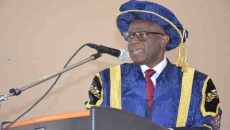By Omobola Johnson
It appears to me that there is not a week that goes by without an event in Nigeria where broadband is not being discussed. All over the world, broadband or more importantly, universal access to broadband, is becoming a significant indicator of development and competiveness amongst nations. Some countries have gone as far as to define access to broadband as (or superfast Internet) as a fundamental human right – as important as access to water, electricity and healthcare. This may actually not be so farfetched when you look at the possibilities and the opportunities that broadband access provides to a country. There are compelling and empirical statistics that tell us that every 10 per cent increase in access to broadband in developing countries results in a commensurate 1.38 per cent increase in GDP. Therefore any country seeking growth, job creation and wealth creation must address their minds to how it can increase access to broadband. Even developed economies like the United States, US, and the United Kingdom, UK, are deploying significant sums of money to broadband access. Recently, the UK announced a £362million fund to improve money to broadband connections in 90 per cent of hard-to-reach communities not catered for by the private sector by 2015. Also recently the US Congress awarded $2.5billion in the Recovery Act funding to help bring broadband services (through fibre) to rural and underserved communities.
Despite the fact that we have Internet penetration of 28 per cent (45million Internet users), only 9 per cent (14.5million people) of the population are actually Internet subscribers and broadband penetration is at a mere 6 per cent. Even though access to broadband using mobile phones (smartphones) is increasing, thereby increasing the number of subscribers, what this statistic tells us is that most Nigerians still access the Internet through public venues (offices, cyber cafes, computer labs). This is as a result of not only the lack of ubiquity of the broadband network but also the cost of access. Today, we have one of the highest costs of access in the world at approximately N8,000 to N10,000 for 5Mbs of data. The average speed of access is still very low. In fact recent statistics that I looked at has us as one of the lowest speeds in Africa.
In essence, we are challenged in all areas of broadband access; coverage, speed and cost.
I would like us to address this broadband issue from four perspectives:
- i) Broadband as a critical national infrastructure
- ii) Broadband as a catalyst for economic growth
iii) Broadband as a means of social inclusive development
- iv) Broadband for effective government and governance
Broadband as a critical ICT infrastructure
Goal: Achievement of one national network capable of delivering broadband speeds of not less than 50 per cent of the average speeds available worldwide at the consumer end within the next five years.
1) How do we facilitate the build-out of a national integrated network in order to distribute the massive capacity from undersea cables?
- Encourage and enforce the principle of open access/infrastructure sharing to already built transmission networks in order to facilitate an integrated national backbone
- Expanding the build-out of an integrated national backbone to achieve point of presence, PoP, in all local government areas.
- Adopt a progressive fibre build-out
- To connect all state capitals
- To achieve PoP in all local government areas
iii. Creation of city rings in all major cities
- Special projects e.g. providing connectivity to key institutions e.g. National Research and Education Network
- Removing the bottlenecks and arbitrary cost additions to infrastructure layout such as cost of right-of-way, conflicting environmental regulations-
- Right-of-way (procurement times, redundancy obligations, service ducts on new highways, cost of right-of-way, supervision of fibre laying)
- Working through our national council to get state governments and local governments to adopt
iii. The National Enviromental Standards and Regulations Enforcement Agency working with the ministry of environment to not only resolve conflicting regulations but to remove all known and unknown bottlenecks to base station approvals.
- Industry committee on illegal taxes and multiple regulations.
- Regulating the cost of access as a last resort.
2) What kind of a national backbone should we be building?
- Heterogenous-
- Wireless (digital dividend spectrum and adoption of ITU regulations by Nigeria. Adoption of white paper on analogue to digital transmission by FEC to commence the process of freeing up the digital dividend broadband)
- Wired (progressive fibre optic build-out and wired local loops)
iii. Satellite resources (speed and hard to reach areas but sacrifice cost)
3) How do we fund the build-out?
- Private sector investment (long term, low interest funding)
- USP funds
- Prioritisation of connectivity
- Increased collaboration and involvement of private sector in planning and development stages
- Direct fiscal support from government (direct intervention, guarantees)
- Multilateral agencies
4) What would be a reasonable average access speed?
Broadband as a catalyst for economic growth
Goal: Increase ICT contribution to GDP by at least 1.5 per cent by 2015
1) How can we use broadband access to stimulate economic growth and create jobs?
- Local content development (mobile applications, media and entertainment)
- Device ownership
- Getting businesses online
- Online businesses (ecommerce and mcommerce) – ulterior motive with NIPOST
- Financial inclusion – mobile money, NIPOST infrastructure
- Supporting SME utilisation of ICTS
- Increasing domestic value added in the ICT industry/local content
- Value-added services
- ICT incubation centres and mLabs
III. Telecoms and other industry inputs (sim cards, cards, base stations, manufacturing)
- ICT parks (ATV,TKC)
Broadband as a means for inclusive social development
Goal:
- Delivering government services via the Internet (e-government and mgovernment)
- Improving government to citizen engagement
- Single window portal to facilitate easy access to government information
- All government MDAs to have functioning, published and informed websites of the same/similar standards by the end of 2014
- Government contact centres
- Leveraging ICT to improve government efficiency and transparency
- Single national database
- Collaboration (email usage)
- Open data (for software developers) – www.yourbudgetit.com
- Complete the implementation of key financial accounting systems
- How do we institute wholesale change management in the civil service to drive the adoption of ICTs in government?
So what I hope I have been able to do is give you an insight into government direction as regarding broadband infrastructure and harnessing the benefits therein.
Follow Us on Social Media




 WhatsApp us
WhatsApp us